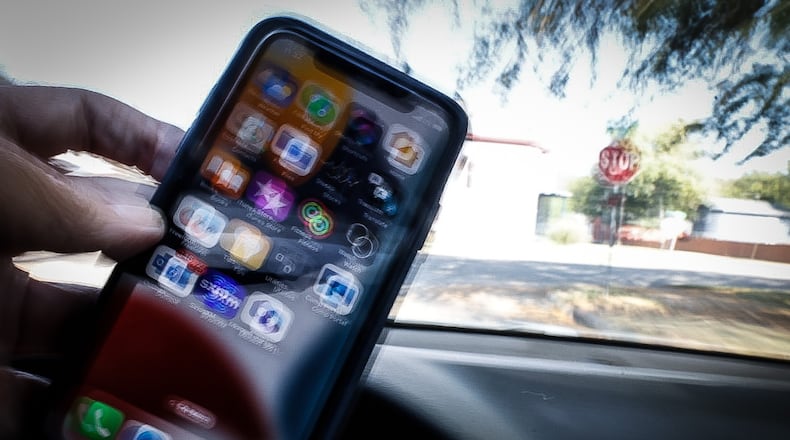Earlier this year, state legislators approved the distracted driving law which makes texting or holding a cell phone in front of you and talking into the speakerphone is now a primary offense. However, drivers are allowed to swipe a phone with one finger to answer a call or hold the phone to their ear to talk.
There also some exemptions to the law, such as being able to talk or text at a traffic light but not at a stop sign.
Early data indicates law is working
Since the six-month warning period started April 4 to Sept. 5, the Ohio Department of Public Safety’s Traffic Safety Office said there has been an 8.5% reduction in distracted driving, according to data collected by Massachusetts-based Cambridge Mobile Telematics. Judy Converse, a state traffic safety office spokeswoman, said the new law prevented an estimated 2,300 crashes, six fatalities and $54 million in property damage since the six-month warning period began.
“Based on the surveys, Ohioans are aware of the new law and are changing their driving behavior,” Converse said.
Ohio has more than 8.2 million licensed drivers, according to statista.com.
Matt Fiorentino, Cambridge Mobile Telematics vice president of marketing, said the company works with 100 insurance companies around the world and with 21 of the 25 top companies participating in the program. He said about 10,000 people surveyed agreed to use the app on their smartphone to monitor their driving behavior, including smartphone data, in exchange for a 30% to 50% reduction on their vehicle insurance.
Credit: JIM NOELKER
Credit: JIM NOELKER
“We can definitely say the new law has reduced distracted driving crashes based over 10 million car trips since March 1,” Fiorentino said. “The law is doing what it’s supposed to be doing. Ohio is off to a great start.”
Credit: Journal News
‘Another tool in law enforcement’s tool belt’
According to the Ohio State Highway Patrol, its distracted driving dashboard indicates troopers have issued 5,284 distracted driving violations from Jan. 1 through Oct. 2. During the same timeframe, troopers have investigated 4,246 crashes of which included 19 fatalities, 168 serious injuries suspected, and 1,173 minor injuries suspected. Fatal and serious injury crashes are down 19% in 2023 year to date from 2022.
Sgt. Tyler Ross, a Highway Patrol public affairs officer, said the new law is just another tool in law enforcement’s tool belt. While the nearly 20% reduction “is encouraging,” Ross said, “there’s always room for improvement. Drivers need to pay attention to the roadway.”
Ross said troopers consistently see distracted driving in the urban areas with rear-end collisions and assured clear distance violations in work zones.
“We expect to see greater improvement after the enforcement begins,” he said. “Sometimes people have to get a citation to understand the message.”
There are more than a dozen of exceptions to the new law, and motorists can still use the hands-free function of their cellphones in their vehicles. Motorists can also talk on a cellphone as long it is held to their ear.
Other exceptions allow motorists to text or use their cellphones while stopped; at a red light; outside the lane of travel on a shoulder; during an emergency to contact first responders or a hospital; stuck in traffic congestion; use of the speakerphone function; one touch or swipe; or receiving navigational, vehicle or traffic information. However, the motorist can not use their body to hold or support the device or enter letters, numbers and symbols.
Police, other first responders and utility workers are exempt from the law.
Starting Thursday, if a driver is stopped for distracted driving, the first offense is a $150 fine and two points on their driving record. A driver can take an education course to drop the two points and fine on a first offense.
However, the penalties increase on a second or third offense and the lookback period is two years. On a second offense, the penalty is $250 and three points on their driving record, and a third offense penalty is $500, four points on the driving record and up to a 90-day license suspension.
Residents aware of new law
Jan Davis of Springboro said she was aware of the new law starting and doesn’t use her cell phone while driving.
Another Springboro resident, Donnie Oswalt, said, “good for them. They (drivers) need to pay attention to driving and not their cell phones. Fine them to to get their attention.
Karen Giardina of Springboro said she wasn’t aware of the new law but that it was good to know.
“I don’t text and I always use hands-free when I drive,” she said. “I’ve seen too many accidents due to texting and driving.
What is ‘distracted driving’
Ohio State Highway Patrol Sgt. Tyler Ross, a public affairs officer, said there are three types of distracted driving:
- Manual: Anything that takes one or both hands off the wheel such as adjusting settings in the car; reaching for objects in the car; or grooming.
- Visual: Anything that causes a driver to take their eyes off the road such as looking at a phone or GPS device; viewing wildlife or pedestrians; staring at billboards, roadside crashes, etc.
- Cognitive: Anything that takes your mind off the road such as speaking with passengers; talking on a cell phone or daydreaming.
Patrol officials said texting while driving is exceptionally bad and unsafe because it incorporates all three forms of distracted driving.
About the Author


